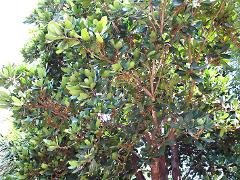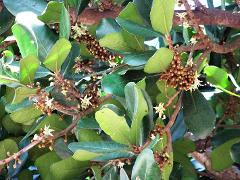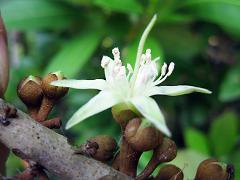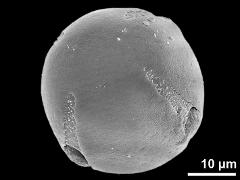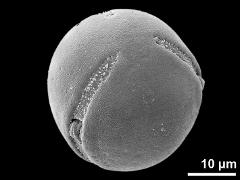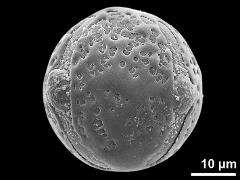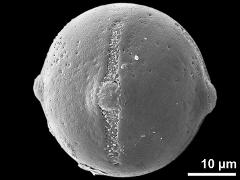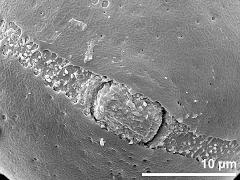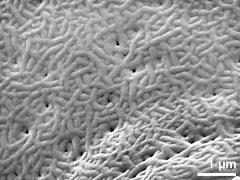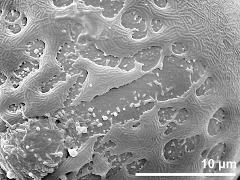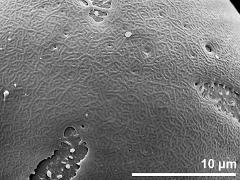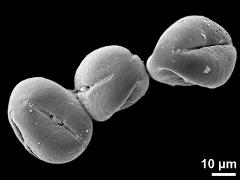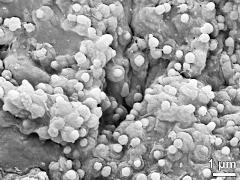Palaquium formosanum
Taxonomy: Angiospermae, Ericales, Sapotaceae, Palaquium
Published: 2016-12-04
Pollen Description
Shape, Size and Aperture
pollen unit: monad, dispersal unit and peculiarities: monad, size (pollen unit): medium-sized (26-50 µm), size of hydrated pollen (LM): -, shortest polar axis in equatorial view (LM): -, longest polar axis in equatorial view (LM): -, shortest diameter in equatorial or polar view (LM): -, longest diameter in equatorial or polar view (LM): -, pollen class: colporate, polarity: isopolar, P/E-ratio: -, shape: spheroidal, outline in polar view: circular, dominant orientation (LM): -, P/E-ratio (dry pollen): prolate, shape (dry pollen): -, outline in polar view (dry pollen): lobate, infoldings (dry pollen): aperture(s) sunken, aperture number: 4, aperture type: colporus, aperture condition: tetracolporate, colporate, aperture peculiarities: -
Ornamentation and Structure
LM ornamentation LM: -, nexine: -, sexine: -, SEM ornamentation SEM: rugulate, psilate, foveolate, suprasculpture SEM: -, TEM tectum: -, infratectum: -, foot layer: -, endexine: -, intine: -, wall peculiarities: -, supratectal element: -
Miscellaneous
pollen coatings: -, reserves in cytoplasm: -, cell number: -, Ubisch bodies: present
Annotations: 3 apertures (colpori) occur as well; ornamentation inconsistent, finely rugulate, sometimes with foveolae
Author(s) of diagnosis: Halbritter, Heidemarie
Pictures
Picture legend
- habitus, photographer: Bellaire, A.
- flower(s), photographer: Bellaire, A.
- flower(s), photographer: Bellaire, A.
- polar view (oblique) - fresh, rehydration (water) & critical point dried & sputter coated with gold, photographer: Halbritter, H.
- polar view (oblique), tricolporate - fresh, rehydration (water) & critical point dried & sputter coated with gold, photographer: Halbritter, H.
- equatorial view - fresh, rehydration (water) & critical point dried & sputter coated with gold, photographer: Halbritter, H.
- equatorial view - fresh, rehydration (water) & critical point dried & sputter coated with gold, photographer: Halbritter, H.
- aperture - fresh, rehydration (water) & critical point dried & sputter coated with gold, photographer: Halbritter, H.
- exine surface - fresh, rehydration (water) & critical point dried & sputter coated with gold, photographer: Halbritter, H.
- exine surface, foveolae - fresh, rehydration (water) & critical point dried & sputter coated with gold, photographer: Halbritter, H.
- polar area - fresh, rehydration (water) & critical point dried & sputter coated with gold, photographer: Halbritter, H.
- dry pollen grains - dry, sputter coated with gold, photographer: Halbritter, H.
- Ubisch bodies on inner locular wall - fresh, rehydration (water) & critical point dried & sputter coated with gold, photographer: Halbritter, H.
Literature
- (1998) Preparing living pollen material for scanning electron microscopy using 2,2-dimethoxypropane (DMP) and criticalpoint drying. Biotechnic Histochem 73: 137–143
Copyright and Citation
Cite this publication as:
Halbritter H., Bellaire A. 2016. Palaquium formosanum. In: PalDat - A palynological database. https://pc8.botanik.univie.ac.at/pub/Palaquium_formosanum/302707;jsessionid=A9C24B21DA35F2530B52276EEB8C519C; accessed 2025-01-10

